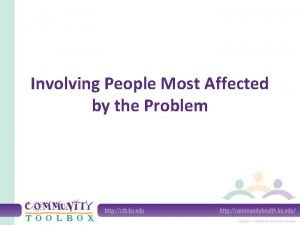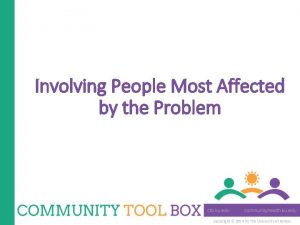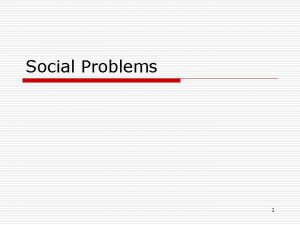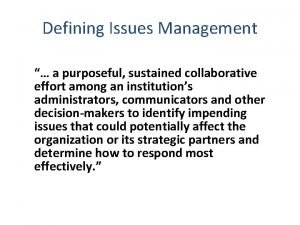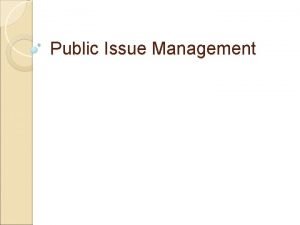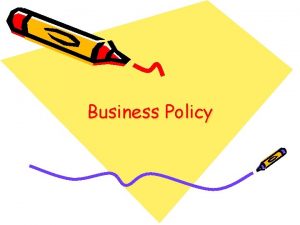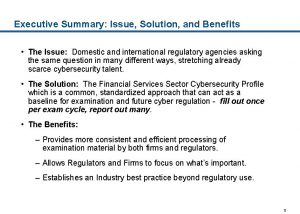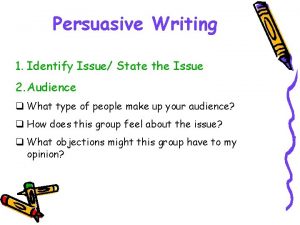Define the Issue and Identify a Policy Solution















- Slides: 15

Define the Issue and Identify a Policy Solution

Step 1: Define. Issue Step 1: • Clarify the problem and develop a problem statement • Use one of many methods to pinpoint causes • Brainstorm potential policy solutions

Identifying Problems—Your Experiences • How did you identify the problem you wish to change through advocacy? • What methods did you use to study the issue? • Which factors supported the decision to identify this as a policy-related issue?

Understanding the Context Consider external influences and political climate What? – problem/issue and its severity Why? – causes of the problem Who and Where? – people affected by the problem; key actors and institutions that make decisions about these policies, and those who influence them

Potential Data Sources • Behavioral surveys • Public policy polling • Demographic and health surveys • Copies of targeted policies • Copies of relevant strategies • Published research on the topic • Media reports on the issue • “Grey literature” on the issue • If available, unpublished research on the topic

Develop the Problem Statement Include the issue, who, where, and the amount: Example 1. Key populations have limited access to HIV testing in ABC region. Example 2. There are no SOPs to address considerations for key populations at HIV testing facilities in ABC region.

Activity—Root Cause Analysis

What are the symptoms (effects)?

What are the causes?

Policy Change • Which root causes can be addressed via policy change? • Remember policy change includes: – Eliminating a harmful policy – Reviewing or revising an existing policy – Enforcing an existing policy – Developing a new policy – Funding a policy

Additional Questions to Ask about the Root Causes • Do you have any evidence that this is a problem? • Is there a coalition or group of organizations interested in working together to address the problem? • Does your organization/coalition have experience with this problem? • Is there any risk to your organization in addressing the issue? • Is the political environment appropriate to address the issue? • Will a policy change significantly affect the problem? • Can the problem be reasonably addressed in three to five years? Adapted from: A 2 Advocacy Training Manual, 2007; Greater Health Impacts, 2013; Advocacy in Action, 2003.

What is a policy solution? • A policy change that can be made to address the problem at hand • Solutions should be policy focused, rather than programmatic • Not every issue is best resolved through advocacy

Questions to Determine Appropriate Policy Solutions • How feasible are the policy actions for your country? • What is the political will for change for each potential solution? • Are there policy revisions currently under way addressing the problem? • Could implementing the proposed solution potentially result in adverse consequences? • How much difference will the policy action make to the issue in your country/region? Adapted from: Greater Health Impacts, 2013.

Activity—Conduct a Root Cause Analysis 1. Using the prework and the guidance from your handouts, conduct a root cause analysis to determine the recommended policy solution for your advocacy strategy (60 minutes for analysis). 2. Report to the large group (5 minutes/presentation and 5 minutes/Q&A per group): – The problem – Selected root cause – Proposed policy solution and the type of policy change (eliminate, revise, new, enforce, or fund)

Learning Objectives—Session 5 • Conduct a root cause analysis during an exercise using information from your prework • Assess problems to determine their strength as advocacy issues • Evaluate policy issues against criteria to determine the strength of the issues • Describe policy solutions for the stated issue
 Who are affected by the problem
Who are affected by the problem Who are affected by the problem
Who are affected by the problem Ideal solution and non ideal solution
Ideal solution and non ideal solution Need and importance of textbook
Need and importance of textbook Innovation enduring issue
Innovation enduring issue Chase and jones issues management model
Chase and jones issues management model What is meant by new issue market
What is meant by new issue market Public issue management
Public issue management Policy solutions definition
Policy solutions definition Thrombolytic prefix and suffix
Thrombolytic prefix and suffix Is auto a prefix suffix or root
Is auto a prefix suffix or root Define open door policy.
Define open door policy. Define big stick diplomacy
Define big stick diplomacy Business policy concept
Business policy concept Define ict policy
Define ict policy Define policy practice
Define policy practice
